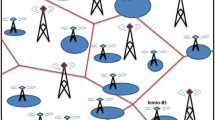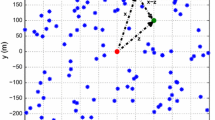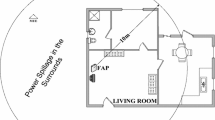Abstract
The concept of extending traditional macrocell cellular structure with small cells (like femtocells) in next-generation mobile networks (e. g., Long Term Evolution Advanced) provides a great opportunity to improve coverage and enhance data rate. Femtocells are cost efficient, indoor base stations. These femtocells can operate in closed mode i. e. only restricted users connection are allowed. Therefore, if the number of deployed femtocells is significant, that can dramatically modify the interference pattern of a macrocell. Thus mobile service providers have to pay attention for the number of simultaneously operating femtocells and encroach, if necessary, to provide appropriate service level to every mobile user. In this paper we provide an analytic framework to characterize the upper bound of service outage probability for a potential macrocell user in a two-tier mobile system, when the radio channels are infected by Nakagami-\(m\) fading. In our proposal the femtocells are operating in closed mode and deployed into a designated macrocell, hence every femtocell increases the interference level. The spatial location femtocells is modelled with Poisson cluster process. Compared to traditional grid structure or completely spatial random Poisson point process femtocell deployment, cluster based layout may provides more life realistic deployment scenario. To evaluate the upper bound of service outage we use the tools of stochastic geometry.




Similar content being viewed by others
Notes
Note that, \(m=1\) yields Rayleigh fading. In this case \(h\) follows exponential distribution with rate 1.
Note that the system is fully loaded, therefore \(\sigma ^{\mathbf{x},j}=1\) always.
References
Small cell market status—Informa (2013). http://www.smallcellforum.org/resources-reports. Accessed November 13, 2013.
3rd Generation Partnership Project; Technical Specification Group Radio Access Network; Evolved Universal Terrestrial Radio Access (E-UTRA) and Evolved Universal Terrestrial Radio Access Network (E-UTRAN); Overall description; Stage 2 (release 11), 3GPP TS 36.300 V11.4.0 (2012). http://www.3gpp.org/ftp/Specs/html-info/36300.htm. Accessed November 13, 2013.
Saeed, R. A., Chaudhari, B. S., & Mokhtar, R. A. (2012). Femtocell communications and technologies: Business opportunities and deployment challenges. Hershey: IGI Global.
Nagata, S., Benjebbour, A., Kishiyama, Y., et al. (2013). Trends in small cell enhancements in LTE advanced. IEEE Communications Magazine, 51(2), 98–105.
Kim, Y., Lee, S., & Hong, D. (2010). Performance analysis of two-tier femtocell networks with outage constraints. IEEE Transactions on Wireless Communications, 9(9), 2695–2700.
Chen, C. S., Nguyen, V. M., & Thomas, L. (2012). On small cell network deployment: A comparative study of random and grid topologies. In IEEE vehicular technology conference (VTC Fall). doi:10.1109/VTCFall.6398953.
Andrews, J. G., Baccelli, F., & Ganti, R. K. (2011). A tractable approach to coverage and rate in cellular networks. IEEE Transactions on Communications, 59(11), 3122–3134.
Dhillon, H. S., Ganti, R. K., Baccelli, F., & Andrews, J. G. (2011). Modeling and analysis of K-tier downlink heterogeneous cellular networks. IEEE Journal on Selected Areas in Communications, 30(3), 550–560.
Chen, J., & Wang, L.-C. (2013). Performance analysis of small cells using stochastic geometry approach in Nakagami fading channels. In IEEE/CIC international conference on communications in China (ICCC) (pp. 22–26), August 12–14, 2013.
Chen, S., Jin, H., Li, Y., & Peng, M. (2013). Performance analysis of two-tier femtocell networks in Nakagami-m fading channels. In International conference on wireless communications and signal processing (WCSP) (pp. 1–5), October 24–26, 2013.
Elkourdi, T., & Simeone, O. (2011). Femtocell as a relay: An outage analysis. IEEE Transactions on Wireless Communications, 10(12), 4204–4213.
Ganti, R. K., & Haenggi, M. (2009). Interference and outage in clustered wireless ad hoc networks. IEEE Transactions on Information Theory. doi:10.1109/TIT.2009.2025543.
Illian, J., Penttinen, A., Stoyan, H., & Stoyan, D. (2008). Statistical analysis and modelling of spatial point patterns. London: Wiley. ISBN:978-0-470-01491-2.
Ramirez-Perez, F., & Serfling, R. (2001). Shot noise on cluster processes with cluster marks, and studies of long range dependence. Advances in Applied Probability, 33(3), 631–651.
Cox, D. R., & Isham, V. (1980). Point processes. London: Chapman and Hall. ISBN:0-412-21910-7.
Haenggi, M., & Ganti, R. K. (2008). Interference in large wireless networks. Foundations and Trends in Networking, 3(2), 127–248.
Simon, M. K., & Alouini, M.-S. (2005). Digital communication over fading channels. London: Wiley.
Erceg, V., & Hari, K. V. S., et al. (2001). Channel models for fixed wireless applications. Technical report, IEEE 802.16 Broadband Wireless Access Working Group. http://www.ieee802.org/16/tg3/contrib/802163c-01_29r4. Accessed October 9, 2013.
Tresch, R., & Guillaud, M. (2010). Performance of interference alignment in clustered wireless ad hoc networks. In IEEE international symposium on information theory (ISIT 2010). doi:10.1109/ISIT.2010.5513243.
Jeney, G. (2011). Practical limits of femtocells in a realistic environment. IEEE 73rd vehicular technology conference (VTC Spring). doi:10.1109/VETECS.2011.5956403.
Acknowledgments
The work reported in the paper has been developed in the framework of the “Intelligent cellular network: A Two-Tier Cellular Architecture with Robust Interference Capability and Optimal Resource Management” Singaporean–Hungarian project. This project is supported by the grant TÉT_10-1-2011-0266.
Author information
Authors and Affiliations
Corresponding author
Appendices
Appendix 1: Outage Probability for Non-group User in Case of Nakagami-\(m\)
It is known that in case of Nakagami-\(m\) fading the amplitude (\(x\)) given in (5) follows Nakagami distribution and the received power \(h_c=\frac{x^2}{\varOmega }\) follows Gamma distribution. It is assumed that \(\varOmega =1\). Therefore, firstly we transform the random variable as follows. The new random variable is \(y\) and we substitute
Substituting this new random variable, the pdf modifies to:
Using the total probability law \({\mathsf {I}\!\mathsf {P}}\left\{ \text {coverage} \right\} (\mathbf{z}) \) can be describe in the following form,
Integration by parts equation (22) yields,
where \(\varGamma \left( m,\frac{mT}{P^cg(\mathbf {z})}\cdot y \right) \) and \(\varGamma (m)\) are the incomplete “lower” and standard (complete) gamma function, respectively. Using the well-known properties of Gamma function that \(\varGamma (m,\infty )=0\) and in case of \(m\) is an integer \(\varGamma (m,0)=\varGamma (m)\) implies that:
Invoking the sum version of an incomplete gamma function:
provides the following form for coverage:
The definition of Laplace transform and the \(k\)th order derivate is defined as follows,
Finally, substituting the \(k\)th order derivate to the (23) concludes the proof:
Appendix 2: Proof of Raw Moments
After calculating the fourth power of \(\mathbb {E}_\mathbf{y}\left\{ \Vert \mathbf {x} +\mathbf {y}-\mathbf {z}\Vert ^4 \right\} \) we can apply the expectation operator for the monomials of the calculated polynomial. According to the properties of Thomas cluster process \(\mathbf {y}\) follows normal distribution with zero mean and \(\delta ^2\) variance. Let us introduce the definition of the \(p\)th (plain) moment of a normal random variable:
Therefore substituting the plain moments into the polynomial, we get: \(\mathbb {E}_\mathbf{y}\left\{ \Vert \mathbf {x}+\mathbf {y}-\mathbf {z}\Vert ^4 \right\} = 3\delta ^4+6\delta ^2\Vert \mathbf {x}-\mathbf {z}\Vert ^2+\Vert \mathbf {x}-\mathbf {z}\Vert ^4, \text {which is equals to} \left( \delta ^2 + \Vert \mathbf {x}-\mathbf {z}\Vert ^2\right) ^2+2\delta ^4+4\delta ^2\Vert \mathbf {x}-\mathbf {z}\Vert ^2\) and finishes the proof.
Rights and permissions
About this article
Cite this article
Jakó, Z., Jeney, G. Outage Analysis of LTE-A Femtocell Networks with Nakagami-\(m\) Channels. Wireless Pers Commun 79, 1369–1384 (2014). https://doi.org/10.1007/s11277-014-1934-5
Published:
Issue Date:
DOI: https://doi.org/10.1007/s11277-014-1934-5




